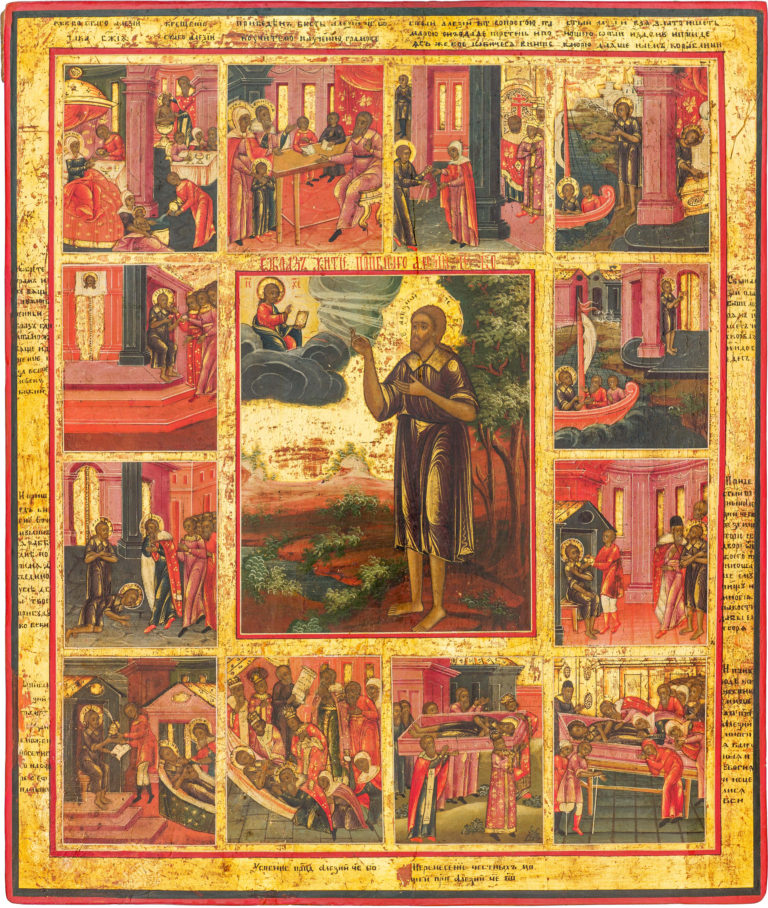Saint Alexius, the Man of God, with 12 Hagiographical Border Scenes
Antique Russian icon. Middle of the 19th century. Vetka.
Size: 41,5 х 34 х 3 cm
Wood (two panels), two incut support boards, absence of an incut centerpiece, an underlying layer of canvas is possible, gesso, tempera, gold.
The author’s paintwork is fairly well preserved. Gilding on the edges and the background of this hand-painted icon is partially chafed. Small fallouts of gesso and paintwork in some places.
Contact us

Saint Alexius, the Man of God, with 12 Hagiographical Border Scenes
Diagram of the border scenes:
- The Nativity and Baptism of Saint Alexius;
- The Education of Saint Alexius;
- Saint Alexius gives his spouse the ring and belt;
- Saint Alexius takes all gold from his house and hires a ship;
- Saint Alexius comes to Edessa, where the Holy Mandylion was kept; dressed as a pauper, Saint Alexius asks for alms on the church porch;
- Saint Alexius flees from Edessa on a ship;
- Saint Alexius comes to his father’s house;
- Saint Alexius accepts food from the master’s table, brought by the servants, and endures with humility from the slaves;
- Saint Alexius writes down his Vita; Euphemianus, the father of St. Alexius tries to take the manuscript from his hands;
- The Dormition of Saint Alexius;
- The Translation of Relics of Saint Alexius;
- Miracles from the Relics of St. Alexius.
The given antique Russian icon is a quite rare representative of famous religious icons of saints. It depicts Saint Alexius – the Man of God († circa 411) who is rightly considered one of the most venerated saints of the Christian world. Alexius (the name of the saint is, in fact, preserved only in the later versions of his Vita) came from a rich and noble Roman family. On the eve of his marriage, he left his home and went to Edessa, where he spent his life on the church porch – in prayer and fasting, humbly accepting alms from those who came to church (according to the oldest – Syrian – manuscript of his Vita). According to the Greek version, seventeen years later, he came incognito to his parents’ home, where he lived for another 17 years, enduring insults from his family’s servants and slaves. Feeling the approach of death, St. Alexius wrote down his Vita and revealed his true origins. At the site of the saint’s coffin – placed amidst the church – those suffering began to be cured. After this, St. Alexius’s relics were brought to St. Boniface Church on the Aventine Hill in Rome. Later the relics were split. In 1414, the head of the saint was brought as a gift by the Byzantine Emperor Manuel II to the Greek Hagia Lavra in Calavrita, while the hand of Alexius was, according to the 17the-century legend, stolen by a Russian merchant and brought to Novgorod’s Saint Sophia Cathedral. The Feast of St. Alexius is celebrated on March 30th (March 17th according to the Julian calendar).
Hand-painted Orthodox icons of St. Alexius became widespread in Russia in the second half of the 17th century, since he was the patron saint of Tsar Alexei Mikhailovich Romanov. Hagiographical religious icons of this saint are quite rare and mainly appear in the Imperial period.
The given antique Russian icon was painted in one of the major Old Believer iconographic centers, on the western borders of the Russian Empire – in Vetka (the territory of modern day Homel, Chernigov, Novozybkov and Klinets regions). This center was formed in the late 17th century. Its cultural and economic blossoming is in many ways linked to the fact that it adjoined regions under the sway of the Polish Kingdom, which appeared to be much more tolerant to various religious movements. And it was here that the Old Believers – persecuted by the Tsar – could find a safe haven. Gradually Vetka became one of the main spiritual centers for the Old Believers, a place where Eastern Orthodox iconography flourished. One of the main religious icon traits of the Vetka masters is the coloristic and ornamental richness of their compositions, the combination of red and crimson, floral green, blue and pink tones, as well as the thick gold background. Another characteristic trait of Old Believer hand-painted icons is the amount and size of texts placed on their borders.
This rare antique Russian icon is in a very good condition and can easy become a gem of any religious icon art collection.